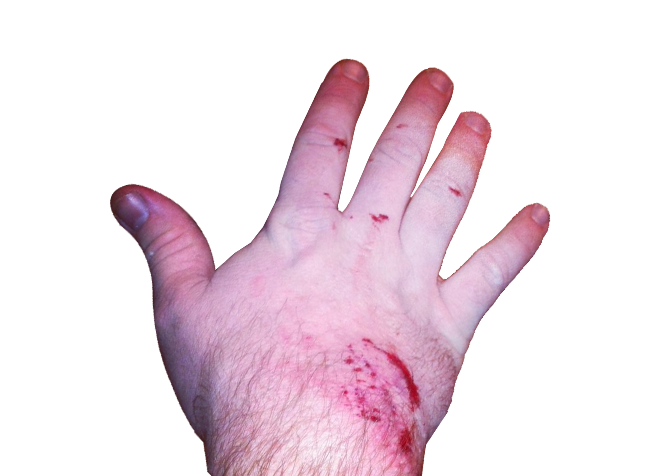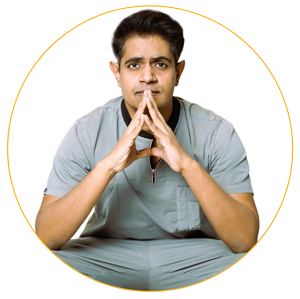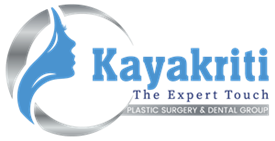Hand Injuries
Hand Injuries
Hand is composed of skin, muscles, tendons, nerves, arteries, veins, bones and ligaments.

Hand is composed of skin, muscles, tendons, nerves, arteries, veins, bones and ligaments. All the components mentioned above are equally important for a hand to function properly. In cases of hand injury-
- The topmost priority has been given to the arteries and veins (vessels supplying blood to the hand) and to the nerves (control function of the hand)
- Proper alignment of bones of the hand is important. Without a stable skeleton, no function of hand is possible
- Functional tendons-both on the front and the back of hand are important for movement of the fingers and thumb
- Ligaments are important for stabilization at the joints
- Skin, though given the least priority is the most important vital structure of the hand. Without a suitable skin cover, none of the structures of hand will function or even heal if repaired.
Isolated injuries to tendon, vessels or nerves usually are rare. Often hand injuries are a combination of injuries to the vessels, nerves, tendon and bone.
Hand injuries are very commonly associated with fractures of the hand. Fixation of fractures of the hand are done as the first step in the treatment of hand injuries. They always have to be ruled out even in small injuries of the hand. Without a stable skeletal network, every repair will fail.
Sometimes the whole hand or finger is amputated and then reimplantation of the cut body parts has to be done as an emergency procedure within 6 hours of the injury.
If the skin and soft tissues of hand is damaged, then various types of resurfacing techniques are available as discussed in soft tissue defects of hand. A soft and pliable skin cover resembling as close as possible to the native skin is mandatory for a hand to function smoothly.
Repair of the damaged nerves of arm, forearm and hand is vital for muscle function and sensory input from the hands. There are 3 major nerves in the hand-median, ulnar and radial. All of these nerves are equally important and have specific functions. Any injury to these nerves at any level of arm, forearm and hand should be repaired as per the general principles and guidelines which are laid down for better understanding in nerve injuries of hand.
Surgery for hand injury is a long, time taking and skillful procedure in which all the small blood vessels, tendons and nerves supplying the cut part of the hand are sewed again together under very high magnification through a microscope by a skilled plastic surgeon.
Points to remember in Hand Injuries-
- Do not panic, try to keep the situation under control and call for help
- Hand injuries can be acutely painful even if they are very small. Hand elevation will help.
- Search for the painkillers like ibuprofen and combiflamat home or workplace. If they are not available, search for any other medication you definitely know is for pain. Take it or give it to the patient with sips of water.
- If hand is bleeding, raise the hand above the level of heart and cover it with a soft clothing. Do not make the cloth very tight which can hamper the blood circulation of the damaged part.
- Remove all constructive items like rings, bangles, watches from the hand without fail.
- Always consult an experienced hand surgeon, preferably a plastic surgeon if your symptoms do not subside even after 48 hours of the injury and treatment at home
- If any part of the hand or finger is amputated or detached from the body, do not lose hope. Gather courage, pick up the body part, store it as mentioned in reimplantation of cut body and rush to a plastic surgeon trained in microvascular surgery.
- Many times, it is not possible to effectively examine a patient with hand injury because of the tremendous pain he or she is going through. Even the examination done to test the integrity of tendon, nerve and bone is not reliable as the patient cannot comprehend or understand commands due to pain.
- Always listen to the advice given by a hand surgeon. He might be explaining- different ways or modalities of treatment, stages of reconstruction if required for treatment. Do not try to chalk out your own treatment plan for the hand injuries
- If primary care or treatment for stopping the bleeding is given at a remote place, always consult a plastic surgeon as soon as possible. Do not think the treatment is over. Though they would have done the best job possible as per their skill and knowledge, but a proper consult with a plastic surgeon is A MUST as soon as possible. There are many places where things go wrong like placement of thicker sutures which could strangulate the blood supply of the already compromised vascularity of the fingers and hand. They could have taken major vessels or nerves in the suture in an attempt to stop the bleeding or could have missed repairing any important structure necessary for hand function.
- Early detection and repair is the key for the successful management of hand injuries.
- Successful treatment of hand injuries need participation from both the surgeon and the patient. Surgeon does 60% of the work by diagnosing, fixing and repairing the injuries of the hand. But the sad part is, a successful surgery cannot guarantee a functioning hand unless a lot of effort is put on the part of the patient and the attendants which accounts for 40% of the treatment. Regular physiotherapy, following exercise regimens and regular follow ups are much more important than only thinking about capabilities of a surgeon.
Isolated injuries to tendon, vessels or nerves usually do not happen. Often hand injuries are a combination of injuries to the vessels, nerves, tendon and bone.
Cut Tendons of the Hand
Tendons are cord-like structures running from the forearm across the wrist and hand and into the fingers. Tendons allow you to bend or straighten your fingers and thumb to grasp an object or make a fist/open a fist. Injuries to the tendons lead to lose the ability to bend or straighten one or more of the joints in the hand.
Tendons present on the front of the forearm and palm which help in making a fist are the flexor tendons. Flexor tendon injuries typically occur from a cut on the palm side of your fingers, hand, wrist, or forearm. While an open cut may cause a tendon laceration, a sudden and forceful pull against the tendon may cause a tendon rupture.
Tendons present on the back of forearm and hand which help in opening of the fist are the extensor tendons. Extensor tendon injuries occur from cuts over back of the foreram and hand.
Injuries with cut tendons usually occurs after accidents (at workplace, road traffic, glass cut or at home).
- Patients usually complaint of not able to move the affected finger after injury.
- Patient is unable to bend the finger inwards in cases of flexor tendon injury and is unable to lift his or her finger backwards in case is extensor tendon injury
- Painful movements of finger in cases of partial tears.
- Patients can come early after injury or late, months or years after injury.
- Tendon injuries are usually associated with bony injuries.
- Diagnosis is mostly by clinical examination of the hand.
Bony injury is always ruled out with an X-ray. Tendon injury is diagnosed clinically after assessing the muscle functions of hand and fingers. Careful examination of neurovascular status is important. Management of tendon injury depends on location of injury.
Management of flexor tendon injury(injury to tendons on the front of forearm and palm of hand)
- Primary repair of flexor tendon is done as early as possible within 7 -10 days of the injury using Bunnell technique or Pulvertaft technique.
- If tendon is not repaired within a month of injury, then the ends of the tendon are retracted or shortened, then tendon graft is used for repair. The results of tendon graft are not as good as primary repair of the tendon done after the injury.
- Rehabilitation in form of regular physiotherapy is very important to prevent adhesions in tendon.
- The most common rehabilitation protocols are Kleinert and Duran protocols, both programs restrict active flexion and allow passive movement for approximately 6 weeks to ensure adequate healing within the tendons.
- Admission is required only for 2 days which is followed by immobilization and rehabilitation.
- Complications like Tendon adhesions (sticking of tendon to the base), Re-Rupture of tendon and Joint contracture are common if proper physiotherapy and exercise program are not followed.
Management of extensor tendon injury(injury to tendons on the back of forearm and hand)
- Primary repair of extensor tendon is done as early as possible within 2 weeks of the injury.
- Late repairs after 6 weeks of injury might require tendon graft.
- Rehabilitation in form of regular physiotherapy is very important to prevent adhesions in tendon.
- Immobilization for up to 4 to 6 weeks with splinting in extension.
- Graded physiotherapy is started with application of night splint.
- Complications include rupture of repair, tendon adhesions.
Cut Arteries of Hand
Artery or vein can be cut after some injury to hand. Injury may be sharp cut, avulsion injury or crush injury. Hand is supplied with dual blood supply from radial artery and ulnar artery. Fingers also have dual blood supply on either side of the finger.
Injuries with cut artery or vein presents as emergency with active bleed. In such cases bleed is usually controlled with pressure and limb elevation. If bleeding is from a vein, it can be safely ligated without any problem to the hand but if it is an artery, the decision of ligation should be thought of twice.
Preference should be given to restoring the continuity of the artery as early as possible on an emergency basis.
If both the major arteries (radial and ulnar) of the hand or finger are cut, then hand is devoid of blood supply completely. Immediate and emergency surgery should be done within 6 hours of the injury and both the arteries should be anastomosed micro surgically. This procedure is called revascularization procedure which is totally different from reimplantation of cut body parts after amputation.
If a major artery is ligated inadvertently by anyone or a Primary Health caregiver, then arterial repair should be done by an experienced hand surgeon as early as possible with or without the help of a vein graft.
Management of Cut Arteries of Hand
- Patient is admitted on an emergency basis and OT is arranged
- Patient is operated in brachial block or general anaesthesia
- Repair of artery is done using 10-0 or 11-0 ethilon suture under microscope magnification.
- Post operatively, the area is immobilised with splints. Hourly monitoring is required for first 24 hours.
- Heparin infusion for 3 days is given to prevent clotting of blood at the site of anastomosis
- Aspirin + Clopidogrel is continued for 4 weeks for the same reason
- Patient is admitted for about 7-10 days after the surgery
- Complications include Spasm of artery resulting in delayed flow, clotting of blood in the artery resulting in failure or rupture (blow out) of repair if the area is infected
Cut Nerves of Hand
Nerves in hand are cut because of trauma in that particular area. Cut nerves in hand are usually digital nerves. Cut digital nerves presents with decreased sensations over fingers. With late presentations these injuries expressed as numbness of the area.
There could be a possibility of injuries to the median and radial nerves in arm, forearm and hand. Every nerve has a specific function and the area of distribution in hand. Any injury to these nerves at any level of arm, forearm and hand should be repaired as per the general principles and guidelines which are laid down for better understanding in nerve injuries of hand. If nerves are not repaired, it could lead to weakness, deformity and muscle wasting or muscle atrophy of the hand and forearm with unnoticed burn over the finger tipsdue to sensory loss.
General Management of Nerve injuries of hand
- Diagnosis is mostly clinical but can be supplemented byInvestigation like Nerve conduction velocity (NCV) to to confirm.
- Primary repair of nerves is the treatment of choicewhich should be done as early as possible
- Late presentations with deformity and muscle wasting are managed with nerve transfer or tendon transfer
- Patient is kept admitted for 2 to 3 days in surgery for nerve repair
- Immobilization is required to safeguard the repaired nerve
So detailed management of various nerve injuries of hand(Median nerve, ulnar nerve and radial nerve and digital nerve), Refer on the link above.
Know your surgeon better

Best plastic surgeon, Dr. Amit Agarwal is an American Board Certified, extensively trained, and best Plastic & Aesthetic surgeon in Lucknow. He is the Chief Plastic Surgeon heading the Department of Plastic, Microvascular, and Craniofacial surgery at Vivekananda Polyclinic and Institute of Medical Sciences, Lucknow, U.P, India. He maintains a busy practice at Avadh and Nishat Hospital and his own center - Kayakriti Plastic Surgery & Dental Center. He was formerly a Consultant in the Department of Plastic Surgery and Burns at the prestigious SGPGI, Lucknow.
MS, DNB (General Surgery) MCh, DNB (Plastic Surgery),
MNAMS, FACS, FICS, FRCS (Edinburgh, UK)
His Credentials
Three pillars of kayakriti
Privacy
We believe your experience with us should be comfortable and hassle-free to make it one of your best lifetime experiences for yours. We, here at the clinic, take full precautions to maintain your privacy in any manner. We also provide a staff who will receive you from the gate and take you to the chamber directly if you demand.
Trust
Our Surgeon is highly qualified and internationally certified with a team of skilled staff to perform any surgical or non-surgical treatment on your body.
Safety
When you plan to undergo any surgery you should always keep in mind that it's your body and it's a surgery. We, here always keep your safety a priority and will never recommend you to undergo any such procedure which is not safe for you. We also provide you with a detailed description of the complications which may occur after the surgery during the consultation as it's a surgical procedure so there may be some complications depending on the way your body reacts.
Kayakriti in news



Frequently Asked Questions
If you have flat or small breast and you want to improve your breast and hip contour ratio then you are a good candidate for it. The answer will be best provided after the first consultation with Dr Amit Agarwal.
Acute pain will be there for almost a week which gradually reduces and there will be soreness and swelling which may take up to 3 weeks to subside.
You can join your work and daily routines after a week of the procedure and can start exercising after 3 weeks of it.
Yes, you have to wear it round the clock unless we suggest you to remove it.
This surgery does not affect the ducts or the areas of the breast involved in milk production. Thus, it does not affect the breast feeding.
This surgery does not affect the ducts or the areas of the breast involved in milk production. Thus, it does not affect the breast feeding.












Kayakriti Plastic Surgery & Dental Center
D-43, Near Punjab National Bank, Rajajipuram, Lucknow, Uttar Pradesh - 226017, India
Phone No. +919695940009, +919695940006
Map Location





























Social Media Presence